Zihe Liu
Part I: Tricks or Traps? A Deep Dive into RL for LLM Reasoning
Aug 11, 2025Abstract:Reinforcement learning for LLM reasoning has rapidly emerged as a prominent research area, marked by a significant surge in related studies on both algorithmic innovations and practical applications. Despite this progress, several critical challenges remain, including the absence of standardized guidelines for employing RL techniques and a fragmented understanding of their underlying mechanisms. Additionally, inconsistent experimental settings, variations in training data, and differences in model initialization have led to conflicting conclusions, obscuring the key characteristics of these techniques and creating confusion among practitioners when selecting appropriate techniques. This paper systematically reviews widely adopted RL techniques through rigorous reproductions and isolated evaluations within a unified open-source framework. We analyze the internal mechanisms, applicable scenarios, and core principles of each technique through fine-grained experiments, including datasets of varying difficulty, model sizes, and architectures. Based on these insights, we present clear guidelines for selecting RL techniques tailored to specific setups, and provide a reliable roadmap for practitioners navigating the RL for the LLM domain. Finally, we reveal that a minimalist combination of two techniques can unlock the learning capability of critic-free policies using vanilla PPO loss. The results demonstrate that our simple combination consistently improves performance, surpassing strategies like GRPO and DAPO.
Reinforcement Learning Optimization for Large-Scale Learning: An Efficient and User-Friendly Scaling Library
Jun 06, 2025Abstract:We introduce ROLL, an efficient, scalable, and user-friendly library designed for Reinforcement Learning Optimization for Large-scale Learning. ROLL caters to three primary user groups: tech pioneers aiming for cost-effective, fault-tolerant large-scale training, developers requiring flexible control over training workflows, and researchers seeking agile experimentation. ROLL is built upon several key modules to serve these user groups effectively. First, a single-controller architecture combined with an abstraction of the parallel worker simplifies the development of the training pipeline. Second, the parallel strategy and data transfer modules enable efficient and scalable training. Third, the rollout scheduler offers fine-grained management of each sample's lifecycle during the rollout stage. Fourth, the environment worker and reward worker support rapid and flexible experimentation with agentic RL algorithms and reward designs. Finally, AutoDeviceMapping allows users to assign resources to different models flexibly across various stages.
Efficient Model Compression for Bayesian Neural Networks
Nov 01, 2024Abstract:Model Compression has drawn much attention within the deep learning community recently. Compressing a dense neural network offers many advantages including lower computation cost, deployability to devices of limited storage and memories, and resistance to adversarial attacks. This may be achieved via weight pruning or fully discarding certain input features. Here we demonstrate a novel strategy to emulate principles of Bayesian model selection in a deep learning setup. Given a fully connected Bayesian neural network with spike-and-slab priors trained via a variational algorithm, we obtain the posterior inclusion probability for every node that typically gets lost. We employ these probabilities for pruning and feature selection on a host of simulated and real-world benchmark data and find evidence of better generalizability of the pruned model in all our experiments.
NGD converges to less degenerate solutions than SGD
Sep 07, 2024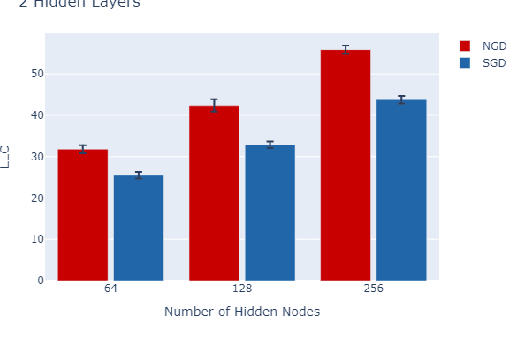
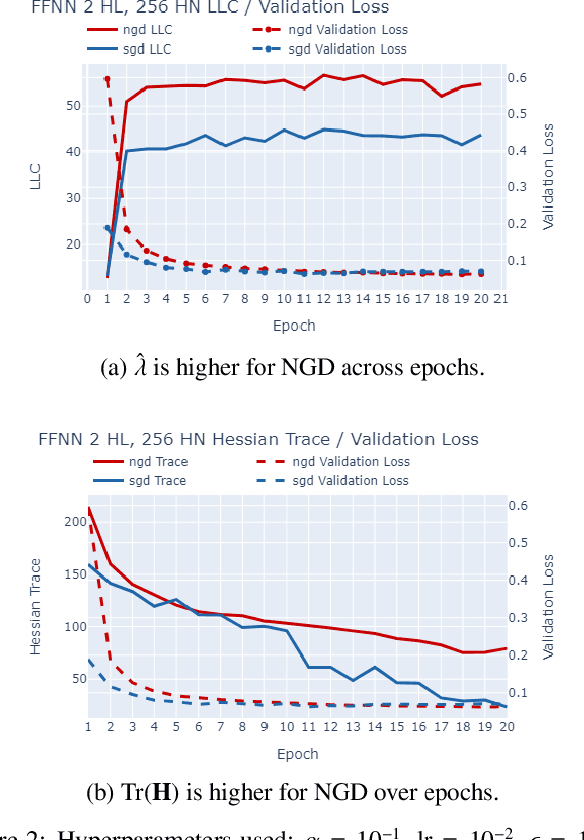
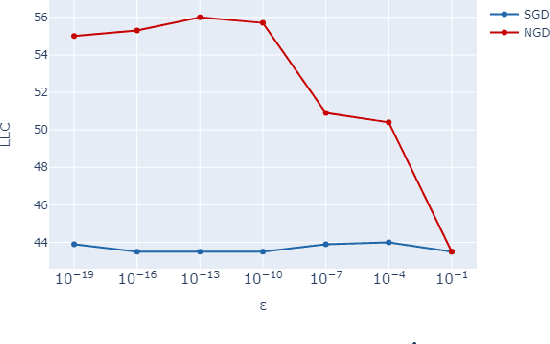
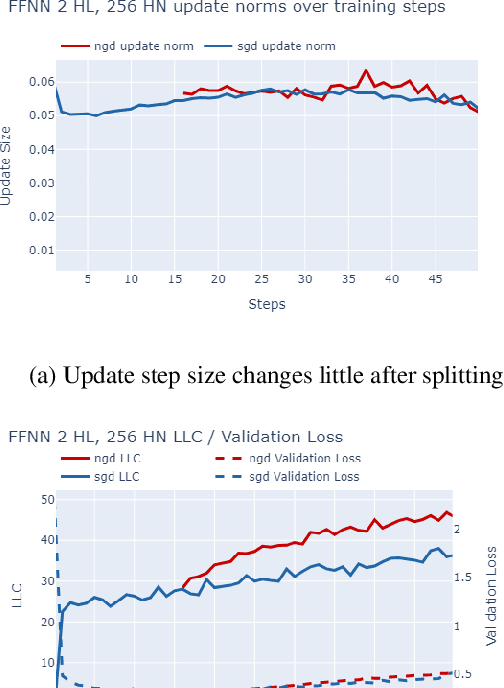
Abstract:The number of free parameters, or dimension, of a model is a straightforward way to measure its complexity: a model with more parameters can encode more information. However, this is not an accurate measure of complexity: models capable of memorizing their training data often generalize well despite their high dimension. Effective dimension aims to more directly capture the complexity of a model by counting only the number of parameters required to represent the functionality of the model. Singular learning theory (SLT) proposes the learning coefficient $ \lambda $ as a more accurate measure of effective dimension. By describing the rate of increase of the volume of the region of parameter space around a local minimum with respect to loss, $ \lambda $ incorporates information from higher-order terms. We compare $ \lambda $ of models trained using natural gradient descent (NGD) and stochastic gradient descent (SGD), and find that those trained with NGD consistently have a higher effective dimension for both of our methods: the Hessian trace $ \text{Tr}(\mathbf{H}) $, and the estimate of the local learning coefficient (LLC) $ \hat{\lambda}(w^*) $.
A Behavior-Aware Approach for Deep Reinforcement Learning in Non-stationary Environments without Known Change Points
May 23, 2024Abstract:Deep reinforcement learning is used in various domains, but usually under the assumption that the environment has stationary conditions like transitions and state distributions. When this assumption is not met, performance suffers. For this reason, tracking continuous environmental changes and adapting to unpredictable conditions is challenging yet crucial because it ensures that systems remain reliable and flexible in practical scenarios. Our research introduces Behavior-Aware Detection and Adaptation (BADA), an innovative framework that merges environmental change detection with behavior adaptation. The key inspiration behind our method is that policies exhibit different global behaviors in changing environments. Specifically, environmental changes are identified by analyzing variations between behaviors using Wasserstein distances without manually set thresholds. The model adapts to the new environment through behavior regularization based on the extent of changes. The results of a series of experiments demonstrate better performance relative to several current algorithms. This research also indicates significant potential for tackling this long-standing challenge.
Relation-aware Hierarchical Attention Framework for Video Question Answering
May 14, 2021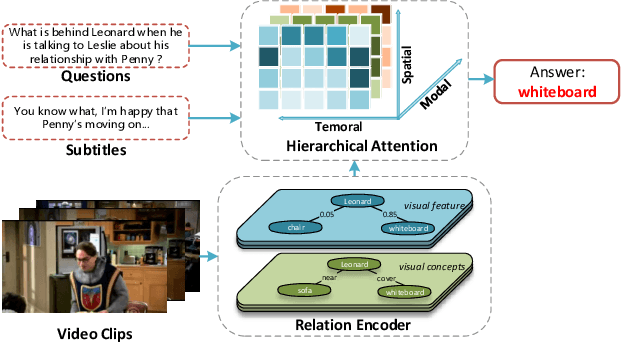
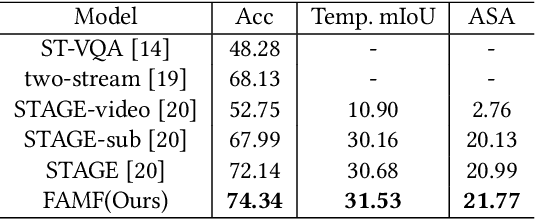

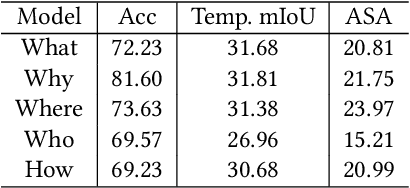
Abstract:Video Question Answering (VideoQA) is a challenging video understanding task since it requires a deep understanding of both question and video. Previous studies mainly focus on extracting sophisticated visual and language embeddings, fusing them by delicate hand-crafted networks. However, the relevance of different frames, objects, and modalities to the question are varied along with the time, which is ignored in most of existing methods. Lacking understanding of the the dynamic relationships and interactions among objects brings a great challenge to VideoQA task. To address this problem, we propose a novel Relation-aware Hierarchical Attention (RHA) framework to learn both the static and dynamic relations of the objects in videos. In particular, videos and questions are embedded by pre-trained models firstly to obtain the visual and textual features. Then a graph-based relation encoder is utilized to extract the static relationship between visual objects. To capture the dynamic changes of multimodal objects in different video frames, we consider the temporal, spatial, and semantic relations, and fuse the multimodal features by hierarchical attention mechanism to predict the answer. We conduct extensive experiments on a large scale VideoQA dataset, and the experimental results demonstrate that our RHA outperforms the state-of-the-art methods.
Frame Aggregation and Multi-Modal Fusion Framework for Video-Based Person Recognition
Oct 19, 2020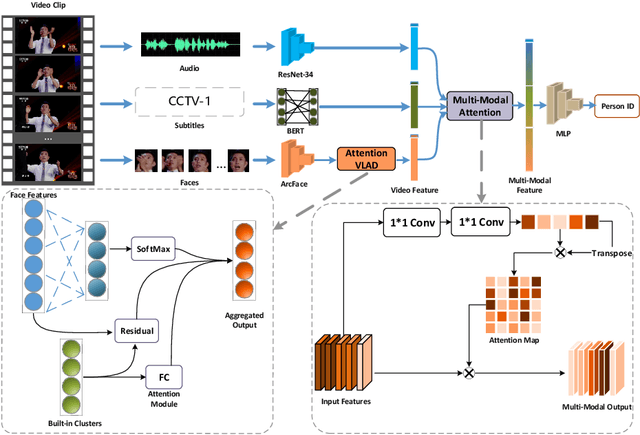


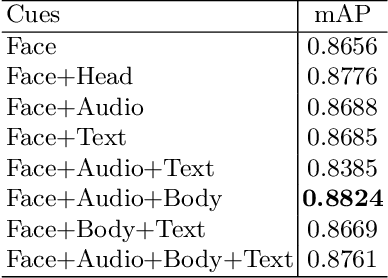
Abstract:Video-based person recognition is challenging due to persons being blocked and blurred, and the variation of shooting angle. Previous research always focused on person recognition on still images, ignoring similarity and continuity between video frames. To tackle the challenges above, we propose a novel Frame Aggregation and Multi-Modal Fusion (FAMF) framework for video-based person recognition, which aggregates face features and incorporates them with multi-modal information to identify persons in videos. For frame aggregation, we propose a novel trainable layer based on NetVLAD (named AttentionVLAD), which takes arbitrary number of features as input and computes a fixed-length aggregation feature based on feature quality. We show that introducing an attention mechanism to NetVLAD can effectively decrease the impact of low-quality frames. For the multi-model information of videos, we propose a Multi-Layer Multi-Modal Attention (MLMA) module to learn the correlation of multi-modality by adaptively updating Gram matrix. Experimental results on iQIYI-VID-2019 dataset show that our framework outperforms other state-of-the-art methods.
 Add to Chrome
Add to Chrome Add to Firefox
Add to Firefox Add to Edge
Add to Edge